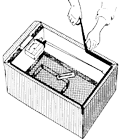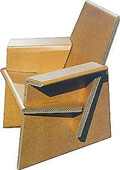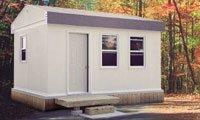
![]()
Search the Journey to Forever website – click HERE
|
Journey to Forever: Make a donation |
Navigation
Contact usTo Keith Addison Handmade Projects |
What to do with a cardboard carton
Which is best?
1. Throw it in the garbage
2. Send it to the waste-recyclers
3. Turn it into a solar box cooker
4. Use it instead of an oven to bake sweet potatoes
5. Turn it into a composter that finally composts itself -- and grow a tree in the compost you make
6. Feed it to compost worms (see Vermicomposting page)
7. Make a Growing Column and grow 50 vegetables in it
8. Hatch 3 dozen eggs in it -- make an incubator
9. Make an armchair
10. Build a house.
Garbage
Most cardboard boxes end up in the garbage dump:
- 9% of the average urban garbage dump consists of cardboard boxes
- 1 ton of cardboard boxes is the equivalent of 17 trees
- Recycling one ton of cardboard saves over 9 cubic yards of landfill space
- Recycling 1 ton of paper uses 7,000 fewer gallons of water, saves 35% of the water pollution and 70% of the air pollution produced in making new paper, uses 4100 KWH less energy, and saves 390 gallons of oil
- In Hong Kong, recycling boxes also helps to support the poor old people who make a living collecting boxes for the recycling presses.
Recycling
So it's better to recycle cardboard boxes. Or is it?
-- November 19, 1998: Hong Kong's only newspaper-recycling company, Concordia Paper Ltd, collapses amid financial difficulties. Waste paper accumulates at the rate of 500 tonnes a day and more than 450 people lose their jobs.
"Even if the [recycled paper] market disappeared entirely, there would be no problem collecting an extra 2,000 tonnes of waste paper a day and taking it to the landfills." -- Deputy Secretary for Planning, Environment and Lands, Kim Salkeld, South China Morning Post
Find out what really happens to the goods you recycle! How can you do that? Find that out too! Ask questions, keep asking until you get the right answers. Don't just hand it over to someone else to take responsibility, take responsibility yourself!
Just as much to the point: do you use recycled paper? Does your family? Does your school? What about other recycled goods? See Recycling facts.
Solar box cookers
One of the best ways to use a cardboard box is to turn it into a solar box cooker. Recycling 60 or so cardboard boxes might save one tree, but one solar box cooker can save at least one whole tree all by itself, each year. Some people think solar box cookers can save the world, and they could be right!
Solar box cookers for schools
Solar box cookers
Solar cooker resources on the web
It takes three or four cardboard boxes to make a solar cooker -- not enough to use up your share of the supply. How many cardboard boxes is each person in your community responsible for each year? How would you find out?
Baked potatoes
So what can you do with the rest of your cardboard boxes? You could burn them, if you have a big enough and safe enough space to do so. Wasteful? What about greenhouse gases?
As far as greenhouse gases are concerned, when you burn a box, or anything made out of trees, you're not creating greenhouse gases, just recycling them. The CO2 released in the fire is reabsorbed by other plants and trees. CO2 levels in the atmosphere don't increase as a result.
As far as waste is concerned, it depends what you do with the fire. First of all, cardboard boxes make a really fine blaze, though it doesn't last long. Second, when the blaze dies down, you're left with a very mild kind of charcoal, glowing softly with a gentle heat, and if you pile it all together in a fireplace made of a few bricks (you need a good, long stick for this), you can use it as an oven.
Baking potatoes in an oven takes half-an-hour at high heat -- and high power bills! Best keep them for the barbecue. But charcoal and wood fires are too hot for potatoes -- the outside gets charred, the inside's not cooked enough, the timing is critical, and the whole thing interferes with the coals you're trying to grill those chicken legs and sausages over. Better to bake the potatoes separately in another fire -- using cardboard boxes. It works much better -- yum!
Bake potatoes, sweet potatoes, yams, taro, squashes, Beach House-style
What you need:
- Some newspaper and a little kindling
- 3 cardboard cartons (eg potato boxes from the supermarket)
- foil
- a long stick
- some bricks, or a barbecue, or, best of all, an old car wheel
- a couple of square feet of wire netting
- an open space
- a bucket of water for safety's sake
Cooking time: anything from 25 to 40 minutes.
If you're using bricks or stones, make a square about 6" high with about 1 sq ft inside for the fire. Wash the potatoes (6-8 quite big ones) and wrap them up in foil (two thicknesses). Crumple up the newspaper pages, separately and not too tight, scatter some kindling on top. Set the newspaper alight. When it's all burning merrily, put the potatoes-in-foil in the bottom of the smallest carton and put the carton on the fire. When the carton's burning well put another carton on top of it, like a lid. Meanwhile the potatoes will fall through the bottom of the first box into the kindling. When the second carton's burning and before the whole thing starts to fall off the fire, put a third carton over it, again like a lid. This makes a great fire! Stand by with the stick to help all the embers fall into the fireplace -- if you get it right, the whole thing should collapse on top of the potatoes. Put some wire netting on top to keep the embers and ashes in.
You can add a dash of the delicious sauce of moral self-righteousness by considering the environmental costs (pollution, global warming, acid rain, etc) if you'd baked all these yummy potatoes in the oven and used up all that energy.
Composting
Still got some spare boxes? Make a composter that finally composts itself. You need two boxes the same size, quite big ones, 18 inches square or more (they don't have to be square).
Open up the flaps at both the top and the bottom, tape the bottom flaps open so you can stand the box on them. Stand it on some sticks or anything you can find that'll keep it slightly off the ground, an inch or so is enough (it's important for compost to breath from underneath).
Scatter a few inches of old dead leaves or something similar in the bottom, they should be slightly moist but not too wet. (You need a lot of old leaves for this, and the drier the better -- collect them in autumn.)
Garden wastes that you can compost usually come in quite small amounts. So do kitchen wastes. You can use them both. For kitchen wastes, get a 2-gallon plastic bucket with a lid, drill a few holes in the bottom and stand it in a plastic tray. Again, put some dead leaves (dry ones) or straw or old hay or torn-up newspaper or cardboard in the bottom. Put your kitchen wastes in the bucket every day (avoid cooked food wastes and meat or fish until you get really good at this). When the bucket's about half full, or when liquid starts to gather in the tray, it's ready to empty -- don't leave it too long!
Mix the kitchen wastes up with about the same amount of dead leaves or more, and put it in the cardboard box. Add more dry stuff on top. Close the top flaps.
Dry stuff:
Dead leaves, shredded cardboard cartons (cut up into strips), shredded newspaper (tear it with the grain into 1" strips -- black ink is non-toxic, avoid glossy paper), shredded computer paper, sphagnum peat moss, coconut coir, chopped-up straw, spoiled hay, yard clippings, dried grass clippings, sawdust, wood shavings (avoid treated wood). Mixed ingredients are better, add a small handful of soil per bucketful.
You can add any garden wastes at the same time. Leave them spread out somewhere dry to wilt until you're ready to empty the kitchen wastes bucket.
When the first box gets full, add the second box, taping the bottom flaps over the opened top flaps of the first box. When both boxes are full, start a new unit with two new boxes. After a couple of weeks, tip the first boxes over, empty them, mix everything up evenly, add more water if it's too dry, and put it back in the boxes again.
A few weeks later it should be finished. By now it should be dark, crumbly stuff. If it got hot during either stage, that is really hot, too hot to put your hand in, and it smells earthy rather than rotten, then you can use it in the garden straight away -- the plants will love it!
If it didn't get very hot, leave it under cover for a few months; keep it moist, don't let it dry out.
After a couple of cycles the boxes will be too rotten to use again; tear them up and use them with the dry leaves. You can use the compost to grow another tree! Or put it in a growing column (see below).
See Composting resources for schools.
See Composting pages.
Feed it to compost worms
Wriggly red worms turn food scraps and organic wastes into nature's best soil to grow more food -- and the worms love eating cardboard cartons (and newspapers). Classroom vermicomposting projects are great for teaching a wide variety of subjects.
See Composting resources for schools and Vermicomposting pages.
Growing columns
Make a column out of 1" chickenwire, 3ft high and 15-16 inches in diameter. You'll need 5ft of 3ft-wide chickenwire, allowing for a 1ft overlap. Fasten it with twists of thin wire. Line the inside with corrugated cardboard from cardboard boxes.
Stand it up on end, hold a 4"-diameter plastic plumbing pipe in the middle and fill the pipe with sand and stones (builder's gravel for concrete is ideal). Fill the rest of the column around the pipe with good soil, packed down enough to prevent it sinking too much later (but not too tightly -- don't compact it). Carefully remove the pipe.
Cut slits 2-3" long through the cardboard in a spiral going round the column from top to bottom. The spiral should go round the column 6 or 7 times, with 6-8" between the slits, making about 50 slits or more.
The sand and stone core is for watering -- water will sink right to the bottom and then spread out to the sides. After you've watered it it will sink a little; top up with more soil and sand.
Plant leaf vegetable and salad crop seedlings through the slits. Water every few days.
This gives a growing area of 12 square feet occupying a very small space. Make sure you put it where it will get enough light, or supplement natural sunlight with growing lamps.
You can make a few columns -- plant them about two weeks apart for a steady harvest throughout the growing season. Five will give an average family lots of delicious, fresh, green vegetables.
See School gardens.
Egg incubator
 Make an incubator out of two cardboard boxes or plywood -- this online schools biology project uses commercial heating elements or light bulbs in porcelain sockets. Expect about a 50% success rate with 3 dozen eggs (commercial incubators: about 80%). See Chickscope 1.5: Resources: From Egg To Chick:
Make an incubator out of two cardboard boxes or plywood -- this online schools biology project uses commercial heating elements or light bulbs in porcelain sockets. Expect about a 50% success rate with 3 dozen eggs (commercial incubators: about 80%). See Chickscope 1.5: Resources: From Egg To Chick:
http://chickscope.beckman.uiuc.edu/
resources/egg_to_chick/incubator.html
See Poultry for small farms.
 Make an armchair
Make an armchair
Corrugated cardboard is strong, especially double-thickness cardboard: this armchair by ReturDesign in Sweden will support anyone weighing up to 100kg. And it sells for US$175!
http://www.returdesign.se/intro.htm
This is a great class project: originality, creativity, and a new way of looking at ordinary things.
Experiment with different designs, see how structural strength can be reinforced. An Internet search for "cardboard chair" and "cardboard furniture" will give you more ideas.
More Swedish designs

Build a house
cardboard 24%
An award-winning new building system in Canada uses mostly recycled cardboard as its primary component. It is lightweight, inexpensive and strong enough to resist heavy snow loads and hurricane winds. These "Instant Houses" can be assembled by unskilled workers in as little as one day.

Recycled cardboard kits for low-cost housing and emergency relief
They're targeted at the longer term "temporary" housing market, including emergency relief, humanitarian aid, remote site development, camps, and tourist cabins etc., where quick and easy transportation and set-up are required. But the manufacturers are planning to evolve the system into the "permanent" residential, utility and cottage markets, among others.
Recycling facts
newsprint 34%
plastic 88%
glass 5%
aluminum 95%